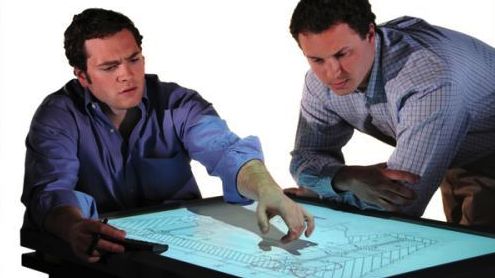Apple's patents come under fire
Though Apple lobs its own punches

It's been Apple's turn to go on the defensive during the third week of the Cupertino company's ragingpatent battle with Samsung.
While still angling to prove it didn't copy the iPhone and iPad, Samsung started pursuing its own claims that Apple's the copycat.
To that end, Samsung "fact witnesses" - as opposed to "expert witness" and the compensation associated with the term - have come out saying Apple's patents are at best invalid and at worst copies themselves.
For a complete look at all the testimony, evidence and trial drama, check out TechRadar's complete Apple vs. Samsung guide.
Fidler's designs
In videotaped testimony, Roger Fidler, program director for digital publishing at the University of Missouri's Reynolds Journalism Institute, said his work on tablet designs extends back to the early 1980s.
A taped Fidler had to do for Samsung as Apple barred him from testifying in person. The court only allowed Samsung to play the tape as it's central to their case.
As reported by Bloomberg, Fidler claims Apple personnel saw his tablet ideas and prototypes in the mid-1990s.
Get daily insight, inspiration and deals in your inbox
Sign up for breaking news, reviews, opinion, top tech deals, and more.
His designs included specifications for features like a flat, no-stylus touchscreen and rounded corners, features Apple claims design and technological patent ownership over.
Fidler's comments fly in the face of Apple's assertion that its iPad and iPhone designs are completely original, with no prior art to prove otherwise.
Furthermore, Fidler's words play into Samsung's claims the smartphones and tablets it was designing around the time Apple said it copied them were merely a sign of the times and not direct Apple rip offs.
The tables are turned
Apple's witnesses spent nearly half-a-day's worth of court time this week and last testifying designs and features like the "rubber band" effect were infringed upon in devices like the Galaxy Epic smartphone.
In his testimony Wednesday, Samsung witness Andries van Dam, a Brown University faculty member, led the jury through one of the allegedly infringed patents, the '381 patent, and why Samsung can't be called out for copying it.
Apple claimed the patent covers its "bounce-back" technology, the feature that brings an image back on screen after a user scrolls to the end and is shown a blank or white screen. When the user's finger is lifted, the image jauntily returns.
Samsung has fixated on invalidating Apple touchscreen patents for some time, last week presenting theTablecloth application on the DiamondTouch Table computer.
The coffee-table sized device projects an image onto a fixed screen and images on the screen can be manipulated with a user's fingertips and includes a bounce-back feature.
Tablecloth's bounce-back was patented in 2005 while Apple's original patent for the feature was filed in December 2007.
Because the Tablecloth application patent was filed before Apple's, van Dam said it invalidates Apple's patent.
van Dam also demoed LaunchTile, a user interface that while on the surface doesn't seem to have the bounce-back feature, van Dam said its software meets the patent's requirements.
Apple, whether intentional or not, didn't mention the Tablecloth or LaunchTile software when it filed for its patent, van Dam said.
"I examined the prosecution history and there's no mention of these two pieces of prior art," he said.
In response, Apple pointed out Tablecloth returns users back to where the image was before bounce-back, while Apple's devices return users to the edge of the content.
Tablecloth's patent, van Dam explained, doesn't specify a point of return, which it apparently doesn't have to in order to protect the feature.
Turning to the device itself, Apple questioned whether the DiamondTouch Table qualifies as a "touchscreen device" at all.
In what seems to be another vague though thorough-enough patent, van Dam explained the patent doesn't "tell you how you implement a touchscreen display."
There was no question in van Dam's mind the DiamondTouch qualifies as a touchscreen display as outlined by the patent.
Then reversed
Though Samsung's arguments and presentations have been compelling, Apple isn't taking any hits without throwing jabs in return.
Apple produced several documents Wednesday "proving" Samsung intentionally ripped off the iPad when it created its Galaxy Tab 10.1 and Galaxy Tab.
Firing more ammunition, Apple brought forth documented correspondence between Google and Samsung pertaining to Google feedback after it saw Samsung's Galaxy Tab 10.1. and the Galaxy Tab.
Dubbed the P3, Google said it needs a more original design for the Galaxy Tab 10.1
"Google is demanding distinguishable design vis-a-vis the iPad for the P3," an executive who summarized a meeting with Google about the devices wrote.
As for the Tab, referred to as "P1," Google didn't pull any punches.
"Since [the P1 and P3 are] too similar to Apple, make it noticeably different, starting with the front side."
Armed with these revelations, Apple aims to prove that despite warnings from outside the company, Samsung decided to go along with its plans anyway.
Testimony continues through the rest of the week with hopes of presiding U.S. District judge Lucy Koh to get the case into jury chambers by Wednesday.
Via Hot Hardware, The Verge and BGR
Michelle was previously a news editor at TechRadar, leading consumer tech news and reviews. Michelle is now a Content Strategist at Facebook. A versatile, highly effective content writer and skilled editor with a keen eye for detail, Michelle is a collaborative problem solver and covered everything from smartwatches and microprocessors to VR and self-driving cars.
